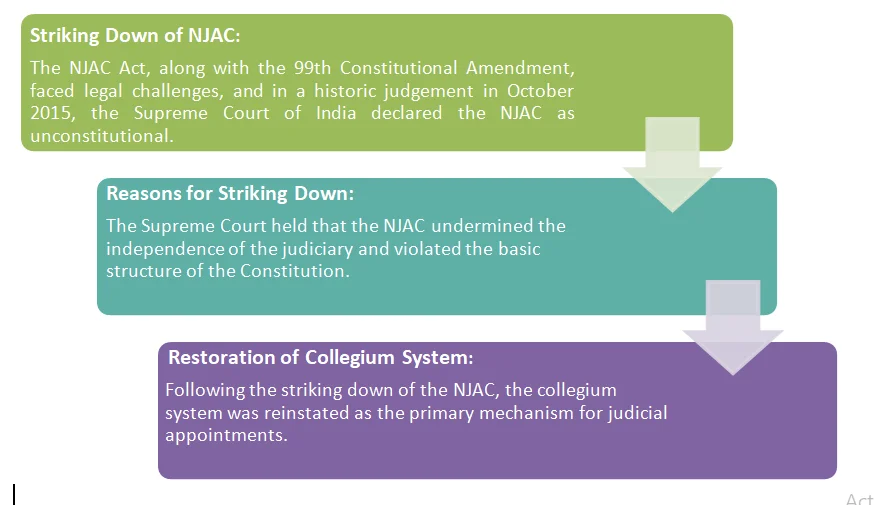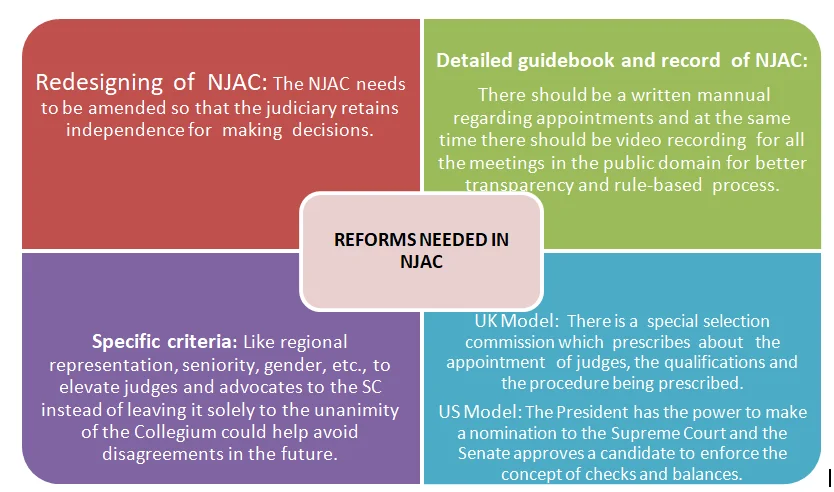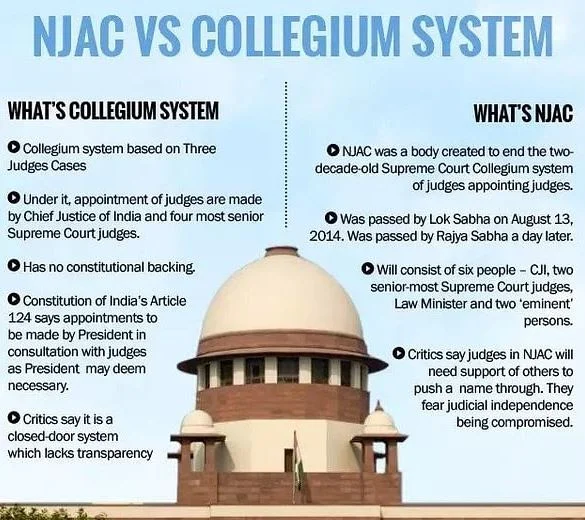The Collegium System and the National Judicial Appointments Commission (NJAC) are two approaches to judicial appointments in India. The Collegium System, established through Supreme Court judgments, gives primacy to senior judges in selecting their colleagues. In contrast, the NJAC aimed to create a more balanced body involving both judicial and executive members to recommend judicial appointments. Understanding the strengths and weaknesses of each system is crucial for improving judicial accountability and efficiency.
The Collegium System vs. National Judicial Appointments Commission: An Analysis of Judicial Appointments in India
Collegium System
- Overview of the Collegium System: It is a system for the appointment and transfer of judges in the Supreme Court as well as the High Court.
- Constitutional Basis: It is not mentioned in the Constitution but has evolved through various judgments of the Supreme Court.
- Composition of the Collegium: In this system, the Chief Justice of India (CJI), along with four senior-most Supreme Court judges, recommends the appointment and transfer of judges.
- Government’s Role: The government may raise objections and seek clarifications regarding the Collegium’s choices, but if the Collegium reiterates the same names, the government is bound to appoint them to the post.
Enroll now for UPSC Online Course
Debates Over Collegium System In India
| First Judges Case (1981):
S P Gupta Vs Union of India |
|
| Second Judges Case (1993):
Supreme Court Advocates-on-Record Association Vs Union of India |
|
| Third Judges Case (1998):
President’s Reference (Article 143) |
|
| Fourth Judge Case (2015):
National Judicial Appointments Commission (NJAC) Act |
|
Issues with the Collegium System
| Lack of Transparency |
|
| Charges of Nepotism |
|
| Against the System of Checks and Balances |
|
| Lack of Representation of Women |
|
| Transfer of Judges
|
|
| Judicial Vacancies |
|
Suggestive Measures For Judicial Appointments
- Reforming the MoP: The ongoing MoP should be reformed which may involve representatives from executive as well as judiciary in decision-making for judges’ appointments to maintain checks and balances.
- Increase Diversity: Adequate representation in judicial appointments should be provided for increasing diversity.
- Increase Transparency: The opinions of the collegium should be released to the public.
- Proceedings of the collegium should be documented and recorded in the form of minutes.
- Expanding Eligibility Criteria: Along with the criteria envisaged in the Constitution for the determination of merit and suitability of the candidate.
- There should be an open invitation for all eligible candidates to apply for the vacancy in the judiciary in the prescribed format.
- Follow Law Commission of India Recommendations:
-
- Equal Role for Judiciary and Executive: There should be an equal role for the judiciary as well as the executive for the selection and appointments of judges to High Courts and the Supreme Court.
- Increase in Retirement Age: The retirement age of the Judges of the High Court should be increased to 65 years, and that of the Judges of the Supreme Court should be increased to 68 years.
- Appointment Sources for Supreme Court Judges: As per Article 124(3) it contemplates the appointment of judges of the Supreme Court from three sources.
- Underrepresentation of Distinguished Jurists: However, in the last fifty years, not a single distinguished jurist has been appointed.
- Limited Appointments from the Bar: From the Bar also, less than half a dozen judges have been appointed.
- Recommendations for Merit-Based Appointments: It is recommended that suitably meritorious persons from these sources are appointed.
- Expeditious Filling of Vacancies: There should be expeditious filling up of vacancies in a continuous manner and along with a collaborative process which involves the executive and the judiciary, and there cannot be a time frame for it.
- Need for a Permanent Independent Body: Currently, there is a need to think of a permanent, independent body to institutionalise the regular process with adequate safeguards in preserving the judiciary’s independence guaranteeing judicial primacy but not judicial exclusivity.
- Safeguards for Judicial Independence: At the same time It should ensure independence, reflect diversity, and demonstrate professional competence and integrity.
National Judicial Appointments Commission (NJAC)
About NJAC: It was a proposed constitutional body in India which aimed for reforming the process of judicial appointments.
- It sought to replace the existing collegium system which vested the power to appoint judges primarily in the hands of senior judges.

- Composition of NJAC: The NJAC was designed to be a six-member body, consisting of the Chief Justice of India, two senior-most Supreme Court judges, the Union Minister of Law and Justice, and two eminent persons nominated by a committee consisting of the Chief Justice of India, the Prime Minister, and the Leader of the Opposition in the Lok Sabha.
- Functions of NJAC: The NJAC was tasked to recommend persons for appointment as Chief Justice of India, Judges of the Supreme Court, Chief Justices of High Courts, and other Judges of High Court and transfer of Judges of High Court.
How Legal Challenges restored Collegium System from NJAC

Issues with NJAC
| Vague Appointment Procedures |
|
| Lack of Expertise Criteria for Eminent Persons |
|
| Absence of Casting Vote for the Chief Justice of India |
|
| Veto Provision in the Selection Process |
|
| Selection Procedure for High Court Judges |
|
Reforms Needed in NJAC
- Role of the Supreme Court as Guardian of the Constitution: The Supreme Court must uphold its role as the guardian of the Constitution and ensure the integrity of the judicial appointment process.
- Need for Transparency and Democracy in Judicial Appointments: Restoring credibility requires a transparent and democratic process for appointing judges within the judiciary.
- Concerns Raised by the Supreme Court in 2015: Acknowledging the Supreme Court’s 2015 verdict, which indicated that “all is not good with the Collegium,” highlights the need for reform.
-
-
- Declaration on NJAC: The Supreme Court of India declared the National Judicial Appointments Commission (NJAC) unconstitutional in October 2015.
- Violation of Constitutional Principles: The court concluded that the NJAC infringed upon the basic structure of the Constitution by jeopardizing the independence of the judiciary.
-
- Proposal for a Permanent, Independent Organization: There is a pressing need to consider establishing a permanent, independent organization to institutionalize the judicial appointment process.
- Ensuring Judicial Independence and Professional Standards: The new organization should preserve judicial independence while ensuring judicial primacy, diversity, professional competence, and integrity.

Difference between NJAC and Collegium

Enroll now for UPSC Online Course
| Must Read | |
| Current Affairs | Editorial Analysis |
| Upsc Notes | Upsc Blogs |
| NCERT Notes | Free Main Answer Writing |
Conclusion
While the Collegium System emphasizes judicial independence, it faces criticism for lack of transparency and potential nepotism.
- The NJAC sought to address these issues by including diverse stakeholders in the appointment process. However, it was deemed unconstitutional due to various flaws, underscoring the need for reforms.
- Moving forward, establishing a transparent and effective system is vital for maintaining the integrity of India’s judiciary.
Sign up for the PWOnlyIAS Online Course by Physics Wallah and start your journey to IAS success today!
| Related Articles | |
| Who is the First Woman Chief Justice of India? | Constitution: A Living Document |
| Supreme Court | Basic Structure of Constitution |

 GS Foundation
GS Foundation Optional Course
Optional Course Combo Courses
Combo Courses Degree Program
Degree Program












